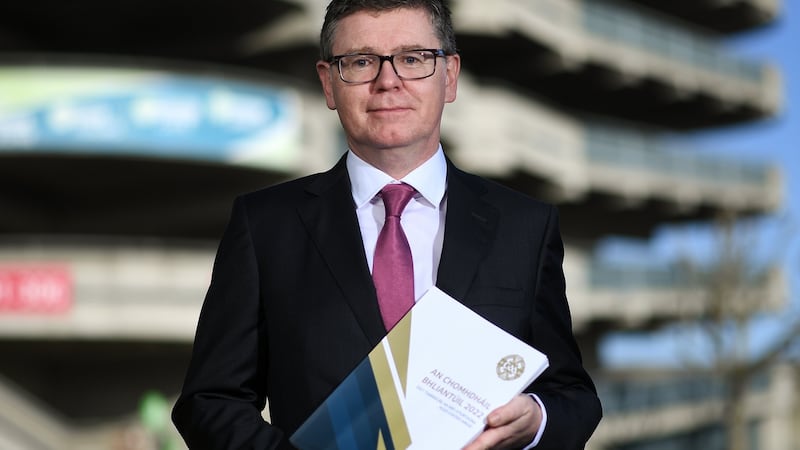GAA DG Tom Ryan has intimated that Dublin can expect a reduction in games development funding under proposals from a review of current funding models. He was speaking at the launch of his annual report in Croke Park on Thursday.
Asked would this affect the county, which has benefited from targeted funding in the past that has been well in excess of what other counties received, Ryan replied:
“I don’t want to get into too much in terms of specific, named counties but it’s fair to say there will be a diminution of coaching and games funding for at least one county and the overwhelming majority of counties will see a significant increase.”

A proposal tabled by six counties and advocated by former Westmeath footballer John Connellan, which proposed to address the imbalance was ruled out of order for the coming congress but Ryan said that it would be debated at Central Council.
He said that a national sub-committee had looked into this matter and come up with proposals, which differ from Connellan’s in the metrics used to distribute development grants. The latter was based on registered membership in a county whereas the former uses a more detailed metric.
“We know there has been much commentary and analysis around this area too,” wrote Ryan in his report, “which is fair and reasonable but it would be wrong for people to suggest this hasn’t been on our radar.
“A subgroup was established by the central games development committee and their work has been guided by a set of key principles. They recently completed a task in the development of a new needs-based investment model . . .”
This proposal, he explained, centres on distributing 75 per cent of the total budget, expected to be €12 million on the basis of three metrics: 60 per cent of this 75 per cent “will be divided among the counties based on the proportion of players in each county, 25 per cent of the funding will be allocated between counties on the proportion of clubs that there are in each county and the remaining 15 per cent will be allocated based on participation rate percentages of each county.”
The remaining 25 per cent will be available for specific projects, such as, “support and a boost for a particular code in a particular urban area; it could be a group of counties within a province to look at underage grades; it could be looking at making the games more attractive to a demographic that haven’t played them before. That portion of it is a more flexible element.”
An issue of concern for the DG was the fact that a number of units had not completed by deadline a risk assessment, as required by child safeguarding protocols. Asked how big a problem this was, he replied:
“It was a very small proportion but it was still a big problem, if that makes sense. Even if it’s only one club it’s still a big problem. That’s a sphere that we have no margin for error at all. The deadline started to loom and as the deadline loomed and as the deadline receded into the rear view mirror the numbers actually went down . . .”
He said that he and association president Larry McCarthy had been forced to intervene to “cajole” people.
“It shouldn’t really have come to that. The authority here is Tusla; it’s not ourselves, and it’s a question of the law so if we find that we’re in a position playing games in an environment that is not legally compliant when it comes to safeguarding people, that’s a real, real problem.”
He also said that penalties would be introduced to discourage this happening in future.
“It’s not fair as well. I can’t remember the proportions but it was 95-plus per cent, more, that were compliant and they put in the time and effort. There’s a reputational thing too and also if we get to a stage where a team can’t play because they’re not compliant, the likelihood is that the opponent that they can’t play against were compliant so we can do better with that.”
He also spoke out on the subject of referees and the abusive behaviour directed at them.
“During the year several referees received unwarranted abuse, which had a profound effect on the people concerned, on their families and also on their colleagues.
“There is little understanding from the general public of the challenges of split-second, on-field decision making. We spectators, supporters, and media commentators must be very conscious of the language we use when criticising from afar.
“As befits the calibre of person they are, our match officials unfailingly take responsibility for the decisions they make - good and bad - as indeed they should.
“They operate in a very structured regime where they are held accountable by independent assessors, by the referee development committee, by the appointments committee, and indeed their peers. But they should not have to take abuse.”
Ryan also addressed the issue of creating one Gaelic games body by integrating the GAA with the women’s football and camogie organisations. He acknowledges that “momentum is building” for a formal coming together.
“However, the core dynamic is still that of three distinct organisations working together. Perhaps the time is approaching when we can build on the progress to date in order that the relationships can evolve to a new level.”
He was careful to separate this issue from the requirement by the end of 2023 to have “40 per cent gender representation” on national sports governing bodies, which he acknowledged was a challenge.












